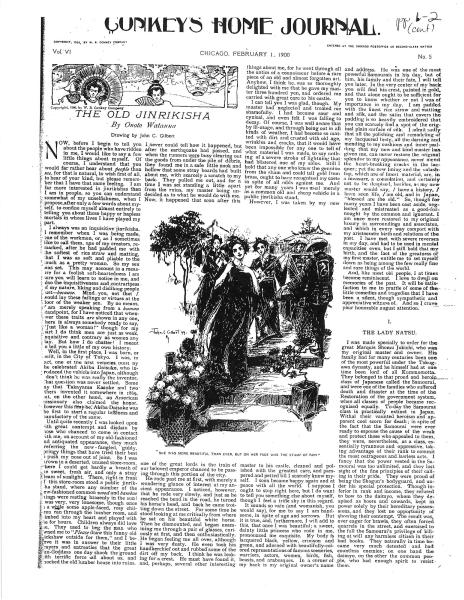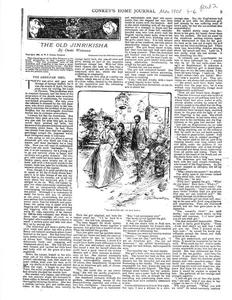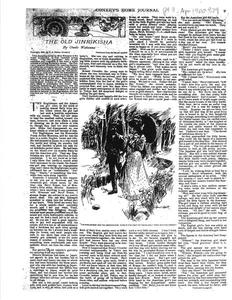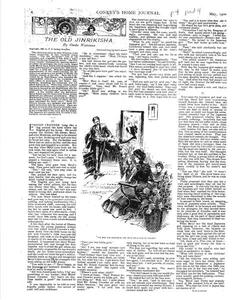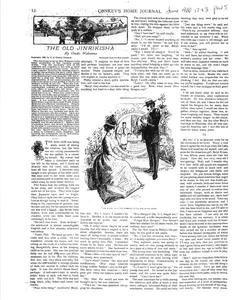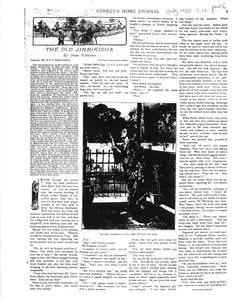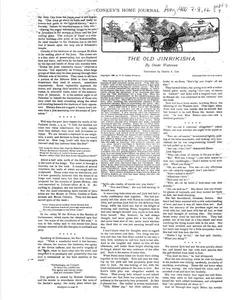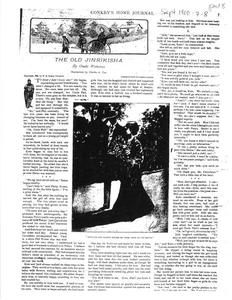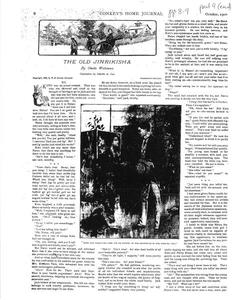Now, before I begin to tell you about the people who have ridden in me, I would like to say a few little things about myself. Of course, I understand that you would far rather hear about
people than
me, for that is natural, to wish first of all, to hear of your kind, but please remember that I have that same feeling. I am far more interested in
jinrikishas1 than I am in people, so you can understand somewhat of my unselfishness, when I propose, after only a few words about myself, to confine myself almost entirely to telling you about those happy or hapless mortals in whose lives I have played my part.
I always was an inquisitive jinrikisha. I remember when I was being made, one of the workmen, or, as I sometimes like to call them, one of my creators, remarked, after he had padded me with the softest of rice straw and matting, that I was as soft and pliable to the touch as a pretty woman. So my sex was set. This may account in a measure for a foolish soft-heartedness I am sure you will learn to notice in me, and also the inquisitiveness and contrariness of my nature, liking and disliking people just—-because. Mind you, not that I would lay these failings or virtues at the door of the weaker sex. By no means. I am merely speaking from a human standpoint, for I have noticed that whenever these traits are shown in any one, there is always somebody ready to say, “Just like a woman!” though for my part I do think men are just as weak, inquisitive, and contrary as women any day. But how I do chatter! I meant to tell you a little of my own history.
Well, in the first place, I was born, or built, in the city of Tokyo. I was, in fact, one of the first vehicles built by the celebrated Akiba Daisuke, who introduced the vehicle into Japan, although I don’t think he was really the inventor. That question was never settled. Some day that Takayama Kasuke and two others invented it somewhere in 1869, but, on the other hand, an American missionary also claimed the honor. However this may be, Akiba Daisuke was the first to start a regular business and manufactory of the same.
Until quite recently I was looked upon with great contempt and disdain by those who chanced to come in contact with me, on account of my old-fashioned and antiquated appearance, they much referring the new-fangled, giddy, springy things that have tried their best to push my nose out of joint. So I was thrown in a deserted, unused store-room, where I could get hardly a breath of the sweet, fresh air, and only a stray gleam of sunlight. There, right in front of this store-room stood a public jinrikisha stand, where any number of the new-fashioned common wood and bamboo things were resting brazenly in the sun! I was very, very lonesome, though once in a while some apple-faced, rosy children ran through the lumber room, and climbed into my heart and played with me for hours. Children always did love me. They used to beg the man who owned me to “Please draw this funny old rickshaw outside for them,” and I believe it was in answer to their little prayers and entreaties that the great Sun-Goddess one day shook the ground with terrific force all about us, and knocked the old lumber house into ruins. I never could tell how it happened, but after the earthquake had passed, and when the runners were busy clearing out the goods from under the pile of debris, they found me in a safe little nook and hollow that some stray boards had built about me, with scarcely a scratch to my back. They pulled me out, and for a time I was set standing a little apart from the ruins, my master being undecided as to what he would do with me. Now, it happened that soon after this one of the great lords in the train of our beloved emperor chanced to be passing through this portion of the city.
He rode past me at first, with merely a wondering glance of interest at my ancient appearance. I noticed, however, that he rode very slowly, and just as he reached the bend in the road, he turned his horse’s head, and back he came trotting down the street. For some time he stood looking at me critically from where he sat on his beautiful white horse. Then he dismounted, and began examining me through a pair of glasses, curiously at first, and then enthusiastically. He began feeling me all over, although I was very dusty. He even took his handkerchief out and rubbed some of the dirt off my back. I think he was looking for a crest. He must have found it, and, perhaps, several other interesting things about me, for he went through all the antics of a connoisseur before a rare piece of an old and almost forgotten art. Anyhow, I think he was so thoroughly delighted with me that he gave my master three hundred yen, and ordered me carried with great care to his castle.
I can tell you I was glad, though. My master had neglected and treated me shamefully. I had become sour and cynical, and even felt I was falling to decay. Of course, I was well aware that by ill-usage, and through being out in all kinds of weather, I had become so matted with dirt and crusted with old age, wrinkles, and cracks, that it would have been impossible for any one to tell of what material I was made, to say nothing of a severe stroke of lightning that had blistered one of my sides. Still, I hold that any one who knew the genuine from the sham and could tell gold from brass, ought to have recognized my caste in spite of all odds against me. And yet for many years I was used merely as a common old and cheap vehicle in a public jinrikisha stand.
However, I was taken by my new master to his castle, cleaned and polished with the greatest care, and pampered and petted till I scarcely knew myself. I soon became happy again and at peace with all the world. I suppose I ought to stop right here, but I do want to tell you something else about myself, though I feel a trifle shy in this regard.
It sounds so vain (and womanish, you would say), for me to say I am handsome, in spite of age and sorrows. But it is true, and, furthermore, I will add to this, that once I was beautiful; a sweet, dainty little princess who rode in me, pronounced me exquisite. My body is lacquered black, yellow, crimson, and green, and adorned with beautifully colored representations of famous sceneries, warriors, actors, women, birds, fish, beasts, and arabesques. In a corner of my back is my original owner’s name and address. He was one of the most powerful Samourai in his day, but of him, his family and their fate, I will tell you later. In the very center of my back you will find his crest, painted in gold, and that alone ought to be sufficient for you to know whether or not I was of importance in my day. I am padded with the finest rice straw and matting and silk, and the satin that covers the padding is so heavily embroidered that you can scarcely find a spot of the original plain surface of silk. I admit sadly that all the polishing and remodeling in my lacquered body, all the darning and mending to my cushions and inner padding that my new and kind master has given me, can never restore the original splendor to my appearance, never mend the heart- breaking cracks in the lacquer; yet the new lining and the calash-top, which are of the finest material, are, in a measure, a consolation, and certainly not to be despised. Besides, as my new master would say, I have a history, I have seen life, I am old, and in Japan, “blessed are the old.” So, though for many years I have been cast aside, neglected and mistreated as a good- for-nought by the common and ignorant, I am once more restored to my original luxury in surroundings and associates, which in every way comport with my aristocratic birth and relations of the past. I have met with severe reverses in my day, and had to be used in menial capacities even, but I still hold that my birth, and the fact of the greatness of my first master, entitle me to set myself down as being among the few really fine and rare things of the world.
And, like most old people, I at times become reminiscent. I love to dwell on memories of the past. It will be satisfaction to me to prattle of some of the little comedies and tragedies that I have been a silent, though sympathetic and appreciative witness of. And so I crave your honorable august attention.
I.
The Lady Natsu.
I was made specially to order for the great Marquis Shomu Jokichi, who was my original master and owner. His family had for many centuries been one of the most powerful under the Tokugawa dynasty,
2 and he himself had at one time been lord of all Kummomotta. They belonged to that proud and heroic class of Japanese called the
Samourai, and were one of the families who suffered death and disaster at the time of the restoration of the government system, when all classes of people became recognized equally. To-day the
Samourai class is practically extinct in Japan. Withal their vaunted heroism and apparent cool scorn for death; in spite of the fact that the
Samourai were ever ready to espouse the cause of the weak and protect those who appealed to them, they were, nevertheless, as a class, essentially tyrannous and oppressive, taking advantage of their rank to commit the most outrageous and lawless acts. I fancy that the power vested in the
Samourai was too unlimited, and they lost sight of the fine principles of their calling in their pride. They were proud of being the Shogun’s bodyguard, and under his special protection. Though inferior in rank and income, they refused to bow to the
daimyo,
3 whom they despised as boors and cowards, kept in power solely by their hereditary possessions, and they lost no opportunity of showing their contempt. The result was, ever eager for brawls, they often forced quarrels in the street, and exercised to the full the
Samourai’s privilege of killing at will any harmless citizen in their bad books. They naturally in time became very much detested and had countless enemies; on one hand the
daimyo, on the other the common people, who had enough spirit to resist them.
And yet, the finest, most noble, in fact, the very flower of the country, were found chiefly among this class. Men of the highest principle and honor, who could not have been otherwise than just and upright, and who were in every way an honor to their calling, these were forced to suffer and bear much opprobrium because of the acts of those who, either from impetuosity or wickedness, made themselves and, therefore, their class, obnoxious to all.
Notable for his goodness, kindness, and justice in those hot and feudal days was my master. Ever ready to keep the peace, and serve the Shogun loyally and well, he, after many years of devoted and unselfish service, retired to his castle which was situated on the shore of the Hayama within sight of Fuji-yama, the peerless mountain, and only a few hours ride from Tokyo.
And it was to his home that I was taken, and where I spent the first few years of my life.
The Marquis Shomu’s family consisted of himself, his wife, and his daughter,
4 the Lady Natsu, whose name means summer. And she was fair as the fairest blush of a summer day!
She was a child when I first came to the family, and we fell in love with each other at sight. Every day her maid would lead her by the hand from the house, and every retainer or servant within sight would bow almost to the ground as she passed, as a mark of respect, and in token that they would serve and protect her forever. Then she would be lifted into my heart (I always like to speak of that part of me as my heart), the maid would clamber in beside her, and away we’d go, and all along the road Lady Natsu would lisp and prattle and chatter and laugh, till it seemed as of the whole world were made of sunshine and smiles. Ah! those were happy days!
She was a child of nature, and nature loved and gave her likeness to her child. Sometimes the runners would run for miles without pausing once. They were the swiftest-footed runners I have ever seen in my day. The runners of to-day—-bah! what with their lying and stealing and wheedling! But Ido and Omi, never were there two such jolly, light-hearted, good-natured creatures! And so it was with all the servants and retainers of my lord’s household. It seemed as if he could only draw about him the good.
Sometimes we would pause by shady spots along the Hayama, some of them luxuriantly beautiful, lovely as a fairyland dream. The slow, scintillating waters of the Hayama, the dazzling blaze of the fields, the endless blue of the skies, nature thrilled with her beauty, and Natsu!—-she laughed and laughed and laughed. She was happy—-we were all happy!
Thus, for ten happy years I was the constant companion of the Lady Natsu. She scarcely went out of the house but it was to be taken somewhere by me, for she was the daughter of a noble, and it would have been unseemly for her to have walked. On the sleeves of all her beautiful gowns there was a gold crest, and the crest was exactly like that painted on my back in gold. The maid would carry their lunches in dainty lacquer boxes that bore the same gold crest.
Sometimes the Lady Natsu would wish to alight while she ate her lunch, and though the maid would not have dared to permit her to do so, had they been within sight of the castle, yet she became quite lax while in the woods, and would even permit her little mistress to perch on one of my shafts held by the runners, whilst she chatted with them and shared her little luncheon just as if she were not the daughter of a great lord, but simply a shining, beautiful little sunbeam!
And the tales she would tell them, the songs she would sing! Sometimes the maid would smuggle a samisen under one of my cushions, and then they would hold the widest, gayest concerts right in the open air. Ido and Omi would go through the most extravagant contortions and antics, to please their little mistress, the maid would play the samisen, and the Lady Natsu would sing and dance. Then, when they would start for home, her head would fall sleepily back against the maid, Oyoshi, and she would murmur, “Please, Oyoshi-san, do not tell my father,” for she feared he would consider this conduct unbecoming, as she was being brought up with all the care and strictness bestowed on the daughters of nobles.
When the Lady Natsu was about fifteen years of age, a terrible disaster overtook her father’s household.
With the fall of the dynasty, the
Samourai lost their rank and power, though as with the last gasp of the dying, they fought for their lords and their rights. A great part of them were killed in frays; many families met together and solemnly took their lives, rather than suffer the disgrace of subjection by those they had ever deemed their inferiors. Among these were my master and mistress. Their estates had been confiscated, their retainers scattered. I will never forget that night, when the souls of my beloved master and his gentle wife passed from their earthly bodies and started on the long, long road to the Meido
5 together. Deserted by friends, hunted by foes, their lands laid to waste, and their wealth stolen, they decided that death surely was more honorable and bearable than life. Faithful to the end, Oyoshi, the maid, remained with them, weeping and sharing with them their sorrows. But when they told her of their honorable decision to die, and bade her bring to them their child, the Lady Natsu, so she, too, might accompany them, Oyoshi wept more bitterly than ever.
She knelt at her young mistress’s feet as she told her of the command of her parents, and begged that she be permitted to give her own life in place of her young mistress’s.
The Lady Natsu’s face blanched whiter than the snows that reflect the sunshine and shadows of Fuji-yama, but her voice was quite steady as she made calm answer:
“Tell my parents that I will go with them. I am willing to obey their august will in all things,” and with these filial words, she began to robe herself in the purest and finest of silks, for she was the daughter of a Samourai, and in her veins flowed the rich blood of bravery and heroism.
When she had finished dressing herself, she went all through the house, bidding farewell to all the loved objects of her sweet life; she kissed the sacred stones and wept before an image of Kwannon, the great goddess of mercy. Then she passed out of the castle, for she wished also to say farewell to the things of nature that had known and loved her.
It was a beautiful spring day. The sun was shining in a gentle, mild, caressing way. Everywhere the exquisite delight of the whitest, pinkest of cherry and plum blossoms against a sky of vivid blue! Natsu sobbed as she gazed at it all. Ah! she was so vital, so full of life! She could not contemplate death with the calmness and indifference of her august ancestors.
And, lastly, she came to me, to say farewell to the old jinrikisha that she had known from childhood. She leaned her head against me in silence. I do not know whether she was thinking of me or not. Perhaps from where I stood at the top of a hill she had a fair vantage point from which to see the beauty of the place she was about to leave. But I like better to think it was sorrow at parting with me that made her climb suddenly into my heart, close her eyes and nestle far back.
I do not know what possessed me. My heart was full. I felt I must do something to save her life. A sudden wild wind moved me a trifle; my back was turned toward the hill, my shafts from it. Suddenly I began to roll—-down, down, down—-on and on—-down the long interminable hill. What forced me along, I cannot say, and worst of all, I felt I was losing all command of myself.
The Lady Natsu sat up and held on to my sides with wide eyes of terror and shrieked aloud. When I came to a standstill, I was quite a distance from the base of the hill, and one of my shafts was broken right off. I stopped with a great jerk, and the Lady Natsu, who had fainted from fright, fell to the ground.
She lay there all that night. The next morning a party of citizens on their road to Tokyo came across us, and brought the girl back to consciousness. They felt very sorry for her, and treated her as gently as they knew how. They told her her parents were now dead, and one of them advised her to go along with them. The girl was weak and trembling, but the sweet, brave spirit in her still was there. She saw there was other women with them, and that they looked good and kind; she understood that her parents were dead, that the Samourai’s power had fallen, that she had nought to depend on but herself, and she still loved life. She went with them.
I was a good deal smashed and battered by my tumble and roll down the hill. On reaching Tokyo, I was sold to a daimyo for a small sum in gold; this man afterward traded me to a merchant for debt, who in turn sold me as a second-hand vehicle to a public jinrikisha stand, where I served for many, many years.
Only once again I saw my mistress, the Lady Natsu. I had been hired with several other jinrikishas to carry a large party of pleasure seekers to a picturesque tea-garden on the highway between Yedo and Kyoto. As I passed in at the gate, a number of giggling, gay geisha girls ran laughingly down to welcome the party. I thought I heard a familiar voice. It was singing the beautiful, though sad, song, “Sayonara” (Good-night). As the last weird, piercing notes died away, she rose to her feet and joined the other girls at the gate. Then I saw her quite plainly. She was the Lady Natsu!—-the same, but not the same. She was beautiful, aye! more beautiful than ever, but on her face there was the stamp of repressed pain and tragedy, and as she saw me—-and I think she recognized me—-her eyes were drowned in a mist of tears.
Her gowns were still of the finest silk, still very rich, and, yes, still bore the proud crest of her ancestors.
I want to say that many of the daughters of the Samourai after the Restoration took up the calling of the geisha girl, and, in fact, may have been the first original ones. It was necessary for them to be beautiful, clever, accomplished. This they were, and more; for they were modest, gentle, virtuous, and refined. The geisha girl of today is common and coarse in comparison. Many great lords, daimyos and nobles chose for their brides girls working in this capacity, so that some of them at least were restored to a life that resembled the luxury and ease to which they had been brought up and become accustomed. Whether the Lady Natsu met this happy fate, I do not know, but I have never ceased to pray the great Goddess of Mercy to dry her tears.
To be continued.
